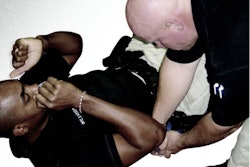As a sergeant in the Los Angeles County Sheriff's Department if I signal that I'm "Code 7," it means that I am going to lunch. If I signal a "Code 77," I am telling my fellow deputies that I suspect a "possible ambush."
Ironically, some cops have found that while they are 10-7, they need to signal a 10-77 because they are about to be ambushed.
While not generally regarded as one of the more obvious dangers of the job, an officer's lunch break is not without its liabilities. Part of the problem is that many officers are not accorded authorized "code 7" time. They're expected to eat whenever the opportunity presents itself. It's little wonder then that fast-food establishments-cheap, easy to find, and often open all night-have proven to be popular food sources for many cops.
Most fast food isn't really good for anybody. It's loaded with fat, cholesterol, sodium, and other bad actors that can cause long-term health problems. However, for cops, a fast-food meal can contain immediate dangers and potentially fatal ingredients that the fast-food company never intended to serve any of its customers.
Something to Chew On
In January, Officer John Florio, a 17-year veteran of the New York Police Department's K-9 unit, picked up a burger from the drive-through window of a major fast-food chain. After parking his patrol car, Florio took a bite of the burger.
But instead of soft, hot, and juicy beef, he bit down on something hard, one of his teeth broke, and something sliced into his tongue and the back of his throat.
Blood filling his mouth, Florio examined the remaining portion of the burger. He pulled off the bun and discovered that embedded in the meat and special sauce were shards of glass.
Florio received treatment for his injuries at Long Island Jewish Hospital, while his fellow NYPD cops conducted a sting operation at the restaurant. Police reports say that a plainclothes officer inside the restaurant watched as employee Albert Garcia Jr., 18, spit into a burger, which he then wrapped, bagged, and handed to a uniformed patrol officer at the drive-through window.
Under arrest, Garcia admitted not only to the previous assault on Florio, but added that he'd taken the trouble of actually bringing the broken picture frame glass into work from home so he could serve it to a police officer. His motivation? A general hatred for cops.
Garcia is not alone in his disdain for officers. Nor is he alone in his opportunity to act on it.
In June 2003, Hillsborough County (Fla.) Sheriff's deputies Stuart O'Shannon and Daniel Witt stopped for food at a McDonald's drive-through. Within minutes, O'Shannon, 32, was airlifted to a hospital with internal injuries. Witt, 24, was also sent to the hospital and admitted.
The cause of their injuries? Employees at the restaurant had mixed broken glass with the onions on the cheeseburgers that they served to the deputies. Col. Jose Docobo of the Hillsborough County SD says that even if the officers had inspected their meal before attempting to consume it, they likely wouldn't have found the glass. "It was very similar in size and color to the onions," he says.
Fortunately, both deputies recovered. However, they are righteously and understandably incensed over the restaurant employee's sneak attack. "I couldn't believe it," O'Shannon recalls. "I take a bite of my Extra Value Meal and immediately my throat feels like it's on fire and I'm coughing up blood."
Nobody's Watching
You wouldn't think a chow run to be such a fateful decision. But these two incidents are representative of a problem that may be on the upswing.
And there's really not much being done about it. The Department of Agriculture tries to do what it can to make sure that food gets to the restaurant as untainted as possible, and various state and local agencies examine the sanitary conditions of eating establishments, but no one is monitoring the actual preparation of customers' meals.
For most customers, including uniformed law enforcement officers, eating at a restaurant is an act of blind faith. Without thinking about it, we bite into our food, totally trusting that the restaurant personnel are not going to attempt to poison us. After all, we are paying them for good food and good service. That's the social contract we have with the restaurant. Unfortunately, what we don't realize is that while the owner of the restaurant has every reason to uphold the terms of that contract, his or her employees may have another agenda.
Food preparers have added everything from chewed gum to dead bugs into customers' burgers. Chicken patties have been marinated with oven cleaner and breakfast burritos laced with all manner of human byproducts. The list goes on and on. But it's not the purpose of this article to make you sick.
It's Not Funny
Everyone should be wary of what can be placed in their food by restaurant employees. But law enforcement officers should be doubly so.
While others have been victimized, cops are popular targets. This is a reality that's been lampooned in movies. For example, in "Super Troopers" Officer Rodney Farva orders a meal, and the kid behind the counter relays the order, making sure to clarify for his unseen co-worker that the food he's preparing is "for a cop." Hilarity ensues when Farva reacts.
But what makes for on-screen laughs is not so funny in real life. In Monroe County, N.Y., three restaurant employees contaminated patrons' meals over a six-month period with cleaning products such as Easy-Off, Kote Soil Shield, and Comet with bleach. All of these products can easily cause burning or irritation in the mouth, and even severe burning of the stomach or esophagus. While cops weren't the sole targets of this idiocy, it was Officer Tony Dominguez who was most seriously injured through their actions.
Even if the substance being ingested isn't intended to kill or even injure us, a restaurant employee's prank could have serious repercussions. With some agencies conducting routine drug screening of their officers, a marijuana-laced taquito could cost an unwitting officer his or her job. In a Colony, Texas, case, the green leafy garnish was discovered inside a burrito before it was eaten and became a point of administrative concern.
Motive and Opportunity
The reasons for people contaminating food can vary. Immaturity might have something to do with it.
They may even be copying something that they saw on TV or in a movie. This is not as far-fetched as it might seem. In 1993, the Walt Disney Co. had to re-edit a movie called "The Program" because of fear that viewers might duplicate a scene in the movie and lay down in the road to get run over by passing semis.
In a world where some people will do anything just because they saw it in a movie, it's not much of a stretch to wonder if movies such as "Super Troopers" sometimes inspire restaurant workers to add special ingredients to a cop's food. "Personally, I think it'd take a pretty weak mind to be susceptible to something like that," speculates Columbus Police Officer Tim Kessler. "But you never know."
Another more likely factor could be a personal grudge. In Illinois, former Denny's night-shift cook Anthony J. Lindhorst was charged with aggravated battery. Authorities say he put his semen into the honey-mustard dressing served with the restaurant's chicken strips. Of the separate known instances, one victim was a Waterloo police officer who'd previously issued Lindhorst a traffic ticket.
Even the Rev. Jesse Jackson admitted in a LIFE magazine interview to contaminating the soups and salads of white customers while working as a waiter in the 1950s. "Spitting into the food gave me a psychological satisfaction," Jackson told LIFE.
Kessler had a taste of such vindictiveness at a McDonald's drive-through. "I'd finished my drink and dumped the ice into a trash container when I noticed a slimy substance coated on the inside of the cup. It looked like saliva."
Unfortunately for the restaurant employee who thought it was funny to spit into drinks, Kessler didn't get the joke. He wrote a report, booked the evidence, then waited several weeks for the state crime lab technicians to conduct their tests.
When the report arrived, Kessler's suspicions were confirmed: Someone had spit into his cup. Interviews were conducted and a subject identified. A warrant was served for DNA testing, and the results left no doubt about who'd spit into the cup. A 15-year-old who was already in trouble with the law for a robbery charge was identified by Kessler's investigation.
A North Carolina Highway Patrol officer, Chris T. Phillips, had a similar experience. Having ordered some Taco Bell nachos at a drive-through window, he scooped some meat and cheese into his mouth. Then, he noticed something. Dangling from a chip, state lab tests later confirmed, was phlegm. Phillips says that an employee who was fired after the incident had complained of being harassed by police about his skateboarding.
Food for Thought
In all fairness, a vast majority of fast-food establishments can be patronized without garnering any aggravation other than being short-changed or getting a wrong food order.
But uniformed and even plainclothes police and corrections officers need to know that they are potential targets for restaurant attacks. And these attacks can leave more than a bad taste in your mouth. Bio-agents and chemical additives can compromise your health, even kill you. Potentially lethal viruses can be transmitted via blood and saliva. And officers who have been served by "spitters" such as Tim Kessler have had to wait weeks to identify the nature of contaminants and to learn whether something toxic or viral may have entered their bodies.
Tracking such incidents is difficult. States vary in their documentation and prosecution of such crimes, depending upon the threat of what is placed upon the food, as well as the victim's status.
Having appropriate documentation made of the incident can offer some peace of mind, and cover you in the event of any possible injury. Depending on the nature of the contamination, blood tests may be in order.
And if you're feeling particularly aggrieved, you may even want to pursue the matter civilly. According to the Wall Street Journal, one upstate New York officer filed a $13.5 million lawsuit against Burger King, its franchisee, and two of its employees after the employees allegedly tainted the officer's hamburger with urine.
Preventing Food Attacks
When it comes to protecting yourself against food contamination, nothing's a sure thing. But here are some suggestions to help make sure you don't become a victim of someone's cruel joke or attempt at revenge.
Communicate with other officers. If you arrested a cook at the local burger joint, let other officers know.
The Oro Valley (Ariz.) Police Department actually distributes occasional memos to warn officers about area food establishments where food contamination might be more likely to occur because they employ people known to have been arrested or to have been suspects in criminal cases. "I just say, 'Listen, be careful; we've seen a lot of people working [at that restaurant] that we've dealt with,'" says Det. Herb Williams of the Oro Valley PD.
If possible, forego the drive-through. Beyond the usual officer safety concern of being a sitting duck, you're often unable to watch the preparation of your food. So go inside.
If the restroom is one commonly used by staff and customers, look around. Is the restroom clean? Is the sliver of soap a good candidate for carbon dating? Is there any soap at all?
Become familiar with the establishment. Don't assume that the water jug holds water. One unwary Michigan State officer took a swig from a friendly looking container only to find it was filled with bleach.
At the order counter, you're apt to be in a better position to know who's preparing your meal and how they're doing it. Some establishments such as Subway have patron-friendly counters that allow you to watch the food prepared before your eyes. Such establishments are now popular with Officer Tim Kessler of the Columbus Police Department who found spit in his fast-food soft drink. "I don't eat anywhere where I can't personally see my food being prepared," he says emphatically.
Most uniformed officers don't like eating in public view. If that's the case with you, get your food inside and go.
Regardless of where you eat on the job, an ounce of prevention applies. The Japanese eat first with their eyes, and you'd be well advised to follow suit.
Look at your food. Give that chicken nugget a sniff check while you're at it. Take your time eating. Chewing your food well can reveal telltale adulterants before they are ingested.
If you suspect that your meal has been adulterated, some establishments have video surveillance of food preparation areas. A review of any available tapes may be in order. The nature of the contamination may require DNA testing of employees. It's important that any suspicion of food contamination be addressed immediately and prosecution sought.
Finally, if the prospect of dealing with bum burgers and toxic tacos raises your anxiety level, remember that there's a lot to be said for microwave meals, peanut butter and jelly sandwiches, and brown bagging it. It's not only safer; it's cheaper and better for you.











